| |
The process of making an Italian-style leather mask was nearly forgotten in the 20th century.
After World War Two, a group of theater artists including Georgio Strehler and Jean Lecoq were interested in reviving the commedia and the art of maskmaking.
They approached sculptor Amleto Sartori, who looked at the surviving masks in museums, scoured the workshops of living maskmakers, and studied the techniques of shoemakers and other leather workers. Eventually he reconstructed the methodology of classical maskmaking, and today these techniques have been learned and are in use by many contemporary maskmakers across the globe.
The Sartoris do their mask forms in wood. For those of us without large workshops, wood carving is impractical, so a variation method is to use a cast concrete form. This is how it's done:
|
| SCULPTURE |
 |
Most masks begin with a sketch, which is then executed in three dimensions using plasticine clay. This photo shows the clay sculpture surrounded by a clay wall, ready for plaster to be poured. |
|
|
| PLASTER MOLD |
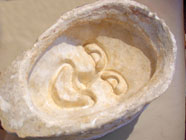 |
The first step is a negative plaster mold of the model. This mold can be used to make "press mold" copies of the mask. I use glue and cotton, linen, or silk cloth to make sturdy fabric versions of my masks which can be painted in acrylics. |
|
|
| POSTIVE MATRIX |
 |
A hard concrete is poured into the negative mold. The positive matrix is backed with wood or wood putty, to make it possible to use nails to attach the leather as the mask is molded to the form. |
|
|
| WORKING THE LEATHER |
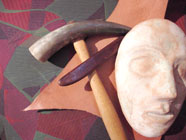 |
The wet leather is worked into the positive matrix mold using a traditional horn hammer and hardwood sticketta. As the leather dries, the mask is gradually formed and the surface of the leather is polished to a high natural gloss. |
|
|
| CUT-EDGE FINISH |
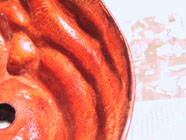 |
The dry mask is removed from the matrix. The standard mask has a cut perimeter edge which is then
waxed and polished.
But the "Pro" level mask is made with an additional step --
a wire is embedded along the rim of the mask which gives it added strength
and durability, and makes it possible to adjust the shape of the mask
to more closely fit the actor's face. |
|
|
| EMBEDDED WIRE FINISH |
 |
To create the "Pro" level mask,, tabs are carefully carved and shaved along the perimeter to hold a piece of milliner's wire (cloth-covered wire) which will give the mask strength and flexibility. This is a time-consuming process, so it does add considerably to the cost (and value) of the mask. |
|
|
ATTACHMENTS:
RIBBON (Standard) |
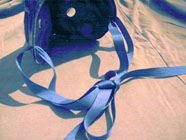 |
There are many ways to attach a mask to the actor's head. My standard mask comes with a traditional grosgrain ribbon attachment. |
|
|
| LEATHER AND VELCRO |
 |
One option is the leather strap with velcro attachment. |
|
|
| LEATHER AND BUCKLE |
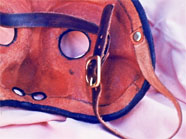 |
Another option is the leather strap with an adjustable buckle attachment. |
|
|
| ELASTIC |
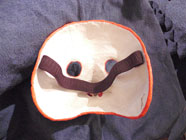 |
The elastic attachment is an option usually used with a fabric mask, but is available for the leather mask if requested. |
|
|
| |
|
|
|
|
|






